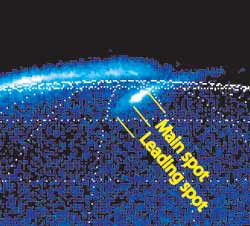Jupiter’s magnetic field is enormous, which is fitting for the King of the Planets. It is far stronger and larger than Earth’s, and, not surprisingly, far more complex. Still, some parts of it are just like home: Jupiter has aurorae.
This has been known for years; the interaction of Jupiter’s magnetic field with its atmosphere creates the northern and southern lights in much the same way that it happens on Earth. But Jupiter has something we don’t: a volcanically active moon.
Io spews sulfur from a series of volcanoes on its surface. The sulfur atoms go up into space, get ionized, and interact with Jupiter’s magnetic field as well. Waves of electromagnetic energy are created, and these travel along the magnetic field lines, slamming into Jupiter’s atmosphere. Io is, in a way, connected to Jupiter, and you can see this connection, literally, as a bright spot of ultraviolet light on Jupiter.
Like on Earth, this happens in both of Jupiter’s hemispheres, producing a Jovian equivalent of northern and southern lights. As Jupiter rotates, the connection spot leaves a glowing trail that fades with time, so it looks like a spiral-shaped comet on the top of Jupiter’s atmosphere. By studying that spot and trail, scientists can learn about the planet, the moon, the magnetic field, and their interaction… and get a surprise or two in the process, too. A new paper just released shows that something unexpected has turned up in Hubble images of Io’s UV footprint: a leading spot, ahead of the main bright spot.
 That’s weird! The bright spot is the place where Io is connected magnetically to Jupiter, so you simply don’t expect to see a spot ahead of that one. Yet there it is. The scientists noticed something else, too: when there is a leading spot in Io’s footprint in one hemisphere of Jupiter, there are multiple spots in the other hemisphere. This led to think that there is more going on here than previously thought. Evidently, there is some sort of magnetic connection between the north and south pole of Jupiter, directly from Io’s northern footprint to its southern one. Something like what happens in a CRT, beams of electrons are being guided from one pole of Jupiter to the other. Compared to the main connection to Io, the connecting beam is weak, so the leading spot is dim, but it’s there.
That’s weird! The bright spot is the place where Io is connected magnetically to Jupiter, so you simply don’t expect to see a spot ahead of that one. Yet there it is. The scientists noticed something else, too: when there is a leading spot in Io’s footprint in one hemisphere of Jupiter, there are multiple spots in the other hemisphere. This led to think that there is more going on here than previously thought. Evidently, there is some sort of magnetic connection between the north and south pole of Jupiter, directly from Io’s northern footprint to its southern one. Something like what happens in a CRT, beams of electrons are being guided from one pole of Jupiter to the other. Compared to the main connection to Io, the connecting beam is weak, so the leading spot is dim, but it’s there.
Here’s what they think is happening: Io blasts sulfur into space. This forms a torus, a doughnut-shaped region of plasma surrounding Jupiter (yellow-green in the illustration above). The magnetic field of the giant planet ionizes the sulfur. As Jupiter’s magnetic field whips past Io, it connects with the moon, and waves of energy flow from Io to Jupiter, creating the bright footprint spot and trail (not shown, but the stream is in blue). The spot is connected to its opposite-hemisphere counterpart by the electron beam (shown in red), and that’s what creates the leading, fainter spot.
This is all very complicated, of course. Jupiter makes a fiercely complex system, and studying it can be very difficult. Observations like this can really mix things up, but the good news is that new data always point us in the right direction, toward truth. And the better news is that in September astronauts will attempt to fix Hubble’s premier ultraviolet camera, called STIS (it’s the camera I worked on in Days Gone By). When it’s fixed, we’ll be able to get higher-resolution images that can see fainter spots, so the picture of Jupiter’s connection with Io will literally become clearer.